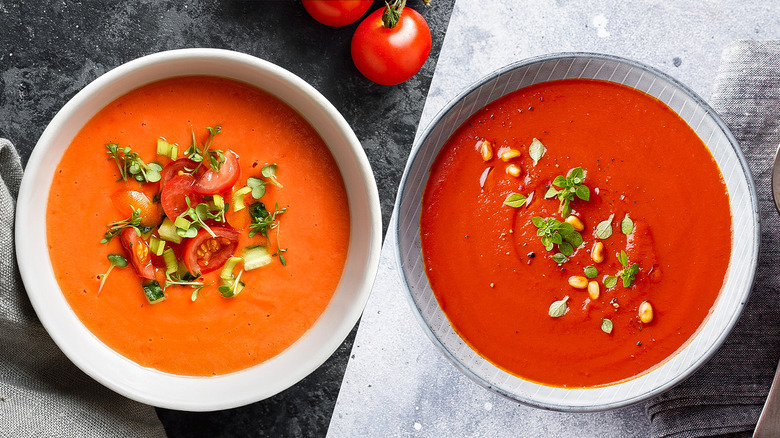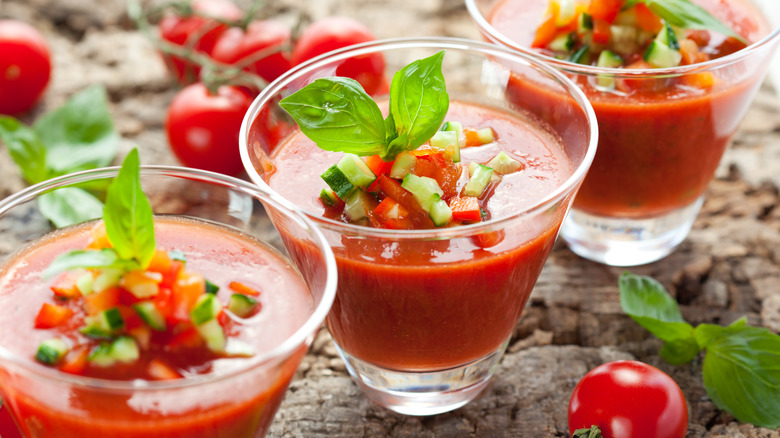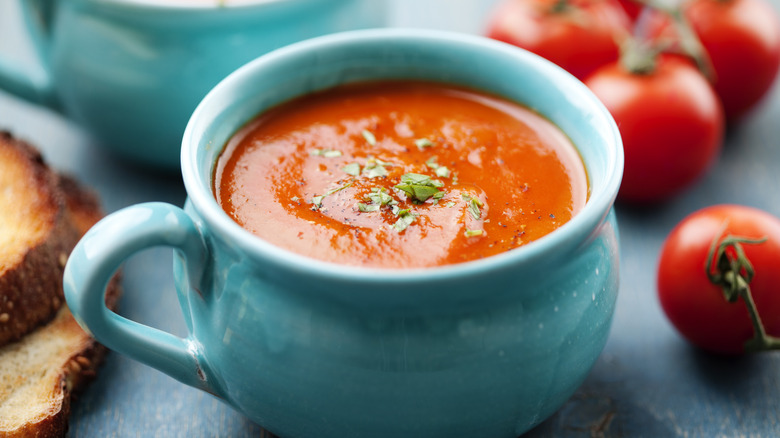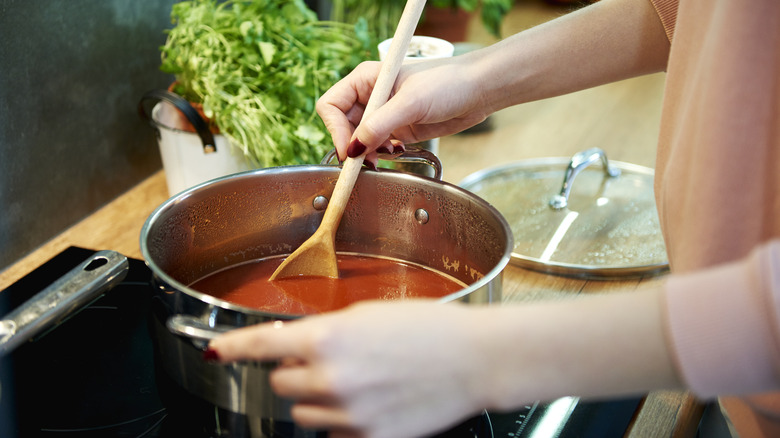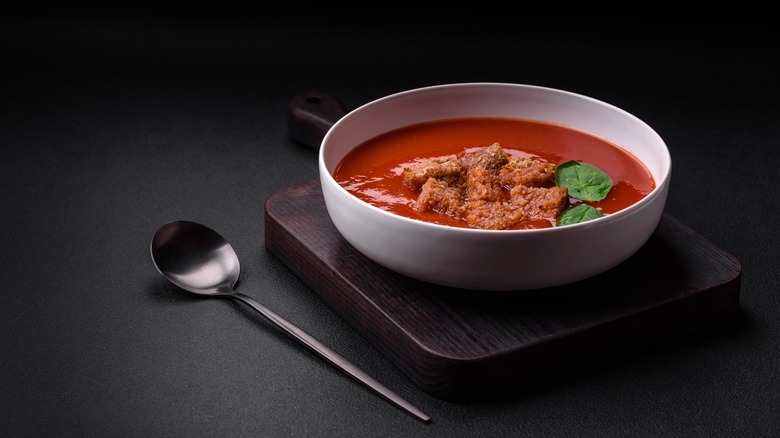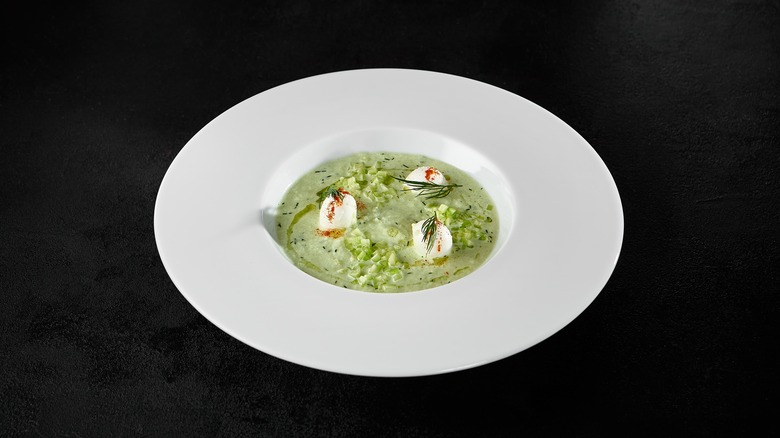Gazpacho Vs Tomato Soup: What's The Difference?
With the ubiquitous use of tomatoes in a variety of cuisines, it's almost unthinkable that they used to be called "poison apples" in the 1700s. For more than a century, most Europeans believed that consuming tomatoes caused death, mistakenly blaming the fruit for the poisonous lead that would leach from pewter plates. The fear of tomatoes even spread to the British colonies in North America, where people thought that tomato worms were as deadly as rattlesnakes. Thanks to developments in agriculture, the prevalent misconceptions about the fruit were eventually overturned. By the 1850s, the tomato was a highly popular produce, prized for its tangy and mildly sweet flavor.
Two of the most enduring dishes that have it as the star are gazpacho and tomato soup. Yet other than the common ingredient they share, these two couldn't be any more different, from how they are prepared and served to their respective flavors and textures. It helps to know what their distinctions are so whenever you have a surplus of tomatoes, either fresh or canned, you'll know what to make depending on what you're craving — whether it's a refreshing Mexican gazpacho or a rich soup to pair with a grilled cheese sandwich.
What is gazpacho?
Before this Spanish dish became known as the perfect cold soup for summer, gazpacho started as a broth made of garlic, olive oil, salt, and vinegar. How its original version reached the Iberian Peninsula remains contested. One version credits the Romans and posits that the name of the dish came from the Latin word caspa, meaning "fragment," in reference to the small pieces of bread that were eaten with it. Another theory believes that the Moors introduced it during their occupation of Spain from the eighth until the 12th century, and that gazpacho comes from the Arabic word for "soaked bread."
Tomatoes weren't cultivated in Spain until the 16th century, and red tomatoes were added to gazpacho only in the 19th century, resulting in the vibrantly colored and refreshingly zesty soup we know now. You can find different recipe variations of gazpacho, but the classic one is the Andalusian version. It has tomatoes and bell peppers as its base, although you can find recipes that include cucumbers and onions.
What is tomato soup?
A rich and savory blend of tomatoes cooked with spices and seasonings, tomato soup is a classic comfort food that has been around since the mid-19th century. The first reference to this dish was made in the 1857 cookbook, "Miss Leslie's New Cookery Book." Written by Eliza Leslie, it cites three kinds of soup — tomato soup, family tomato soup, and fine tomato soup — with each one instructing that the tomatoes be cooked with pure beef before they are strained. Leslie also recommended boiling the tomatoes with okra for better taste and texture.
Today, people have the convenience of buying tomato soup from the store, thanks to the Campbell Soup Company's innovations. In 1895, the brand released the first ready-to-eat, jarred tomato soup made with New Jersey beefsteak tomatoes. Two years later, it introduced the canned condensed version. There's nothing quite like homemade soup, though, especially when the tomatoes are roasted before they're peeled and blended into a puree. It heightens their flavor to create a comforting dish that's perfect on chilly days.
Gazpacho doesn't require cooking
Originally intended to be a refreshing and hydrating summer dish for days when the heat in southern Spain reached 118 degrees Fahrenheit, gazpacho was traditionally served at room temperature. The development of refrigeration technology led people to discover how much better it tasted served chilled, but the point is that its ingredients are treated with the least heat possible.
Before there were blenders or food processors, the ingredients were pounded and mixed together manually using a mortar and pestle, creating a thicker and chunkier soup. Even with the available kitchen gadgets today, there are still those who use this old-school method to avoid exposing the ingredients even to the minimal heat generated by kitchen gadgets. This is also why it's a good idea to store tomatoes and other vegetables you'll be using in the soup in the freezer. Freezing them creates a more flavorful gazpacho, since the cold expands the vegetables' cellular walls, making them easier to break when blended. This allows their flavors to be released fully into the dish.
In comparison, tomato soup requires the tomatoes to be fully cooked in a pressure cooker or on the stovetop so they're soft enough for blending later on. Whereas gazpacho can be either smooth or chunky, tomato soup must be creamy and velvety. Not cooking the produce properly is a common tomato soup mistake that leads to tomato chunks getting caught in the blades of the blender or food processor, resulting in a thin, gruel-like soup.
Tomato soup is seasoned with broth, spices, and cream
Since it's an autumnal dish, a good tomato soup should be rich and hearty. To build on the tomatoes' flavor, the soup is cooked with ingredients that would also thicken its consistency. The usual chicken, beef, or vegetable broth are already good choices, but more home chefs should consider bone broth as a liquid base for tomato soup. Rich in collagen, it adds a silken consistency to the dish to complement its taste. Another texture-enhancing ingredient is cream, which is added right before the soup is served so it doesn't curdle from the heat. Also, a helpful tip for a heartier, tastier soup is sauteing its aromatics in butter so there's more fat to balance the tomatoes' acidity.
Unlike gazpacho, where the fresh flavors of tomatoes and the other vegetables used in the dish are the main attraction, tomato soup tastes even better when seasoned with herbs with complementary flavors. Basil, oregano, rosemary, paprika, and cinnamon are some of the commonly used ones, but you can expand your choices to include the woodsy and earthy marjoram and the citrusy coriander. Spices like curry, paprika, and cayenne can also add heat and smokiness. For any of these seasonings to release and infuse their flavors into a dish, they need heat and time, which the process of cooking tomato soup provides.
Gazpacho is thickened with breadcrumbs
The lack of heat in the gazpacho-making process yields a thinner soup, and this is where breadcrumbs come in to add some thickness to it. Day-old bread is ideal since it's dry and will more quickly absorb the juices from the vegetables, giving the soup more body. It can be any loaf you have around: sourdough, challah, even garlic bread. Remove the tough, dry crust then break the bread into pieces so you can blend the crumbs along with the other ingredients.
To help the breadcrumbs soak up moisture better, place them at the bottom of a bowl then layer the chopped produce on top of it, starting with the tomatoes followed by the vegetables and seasonings. It helps to salt the produce after placing them in the bowl since the salt will draw out their juices, which will then trickle down to the layer of bread. Let everything sit for 30 minutes before mixing them altogether. Afterward, transfer everything into a blender. Strain the puree for a smooth, cold soup or serve as it is if you like it slightly chunky.
Bread can also be used with tomato soup, but only as croutons that are added just before the dish is served to give it a contrasting crunch. For a chunky (but still creamy) tomato soup, adjust how much you blend your roasted tomatoes instead. You can also add crushed and diced tomatoes while the soup is still simmering on the stove top.
Tomatoes aren't always used in gazpacho
We've already established how gazpacho started out as a broth that had no tomatoes in it. Today, there are variations of the dish that also don't use tomatoes at all. Cucumbers can be used in a pinch to make an equally refreshing green gazpacho, and fruits like watermelon and cherries are processed to yield cold rose-colored soups. There is even the white version of gazpacho that's called ajo blanco, which uses almonds and green grapes. All of these variations are less about replacing the featured produce. Instead, they show how gazpacho-making techniques can be applied to different fruits and vegetables.
There are recipes for tomato soup that don't use tomatoes as well, but they were developed in response to people who either don't like tomatoes (but crave tomato soup's heartiness) or are allergic to or intolerant of nightshade; nightshade is a group of vegetables that produce glycoalkaloids, which are compounds that could trigger the body's immune response. These culinary modifications feature vegetables that could infuse the soup with a similar orange-red color. They also rely on seasonings to create an umami and slightly acidic flavor that's reminiscent of tomatoes, but to varying levels of success.
